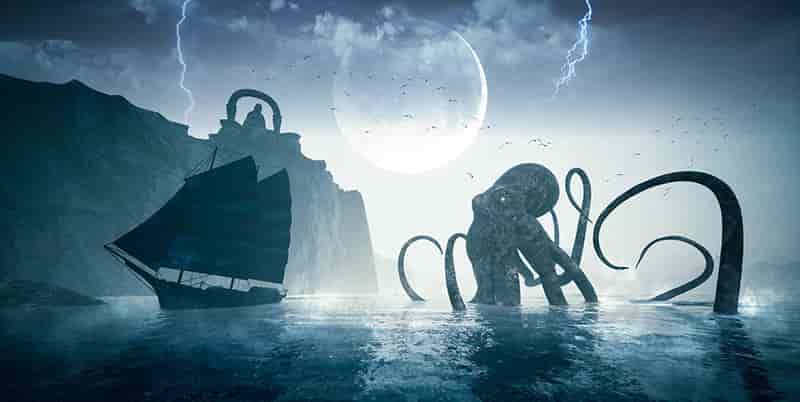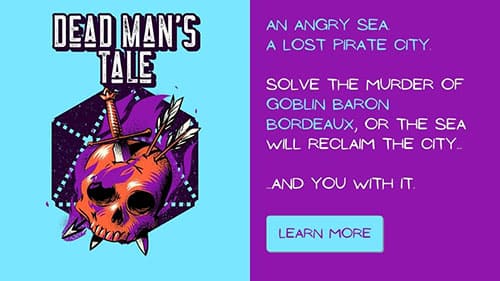The scariest sea monsters in mythology include:
- Hafgufa
- Hafstramba
- Margygr
- Cirein-cròin
- Scylla
- Charybdis
- Cetus
- Isonade
- Umibōzu
- Apocalyptic Serpents—Leviathan/Jörmungandr
- Kraken
Hafgufa
Otherwise known as “Sea Fog” or “Sea Mist”, Hafgufa is an insanely huge Nordic monster. Appearing in Nordic works such as The Kings Mirror, this creature’s nose and jaws jut out of the sea like rocky islands. If sailors mistake the monster’s mouth for land, they may be devoured as the island sinks back into the abyss. Most accounts suggest the Hafgufa has a mate named Lyngbakr, which is kind of sweet in a giant monster sort of way.
Though the hafgufa isn’t on the level of other world-ending giant sea monsters, it holds a unique place on this list as an unseen “mother of sea monsters”. It devours everything smaller than itself and regurgitates fish guts back into the sea for other creatures to eat. In a way, it’s a strange element of nature—a part of the natural cycle of the world. However, the fact that nobody actually knows what it looks like gives it that extra Jaws element of unseen destruction.
Hafstramba
The hafstramba is a humanoid Norse sea monster that is giant, emaciated and possibly just a torso. It isn’t scaly but has icy pale skin and a pointy head. Nobody knows whether its lower half ends in a tail or if it draws out into another sharp point. It’s odd and uncanny, seemingly blending the horror of a corpse and a giant sea monster simultaneously. Again, the horror of the unknown is common with sea tales. However, what makes this sea creature particularly creepy is its ominous nature.
Whenever sailors would come across this strange creature, it meant a storm was on its way. The shy creature would either swim toward the ship or away from the ship as it submerged itself. If it came toward the ship, the crew would lose many men in the storm. If away, the crew has a chance of pulling through.
Margygr
Yet another humanoid sea monster from Norse mythology, the margygr is a giant, horrifying mermaid that lurks off the coast of Greenland. Her eyes are piercing, her hair is wild, and her webbed hands are seemingly too big for her body. Like the hafstramba, she is connected to bad sea storms and was mentioned alongside the strange, pale torsos. Perhaps she is related to the Scandinavian giantess Hafgygr or Grendel’s mother in the Beowulf epic.
Cirein-cròin
The Scottish Cirein-cròin is a mysterious sea creature capable of swallowing 7 whales and is commonly described as a shapeshifting serpent. One moment, it appears to be a silvery fish, luring fisherman into its trap. Once the fisherman catches the strange fish, it transforms into the giant monster and devours the entire ship.
Also, it has been referenced as dinosaur or sea serpent. Perhaps one of its cousins made its way to Loch Ness. However, Nessy would be a much smaller variant.
Related Posts:
Top 9 Scary Japanese Monsters in Mythology
| How to Start a Sci Fi Short Story
|
Scylla
Homer’s famous Odyssey describes two horrifying female monster guarding the Straight of Messina: Scylla and Charybdis.
Per usual in Greek mythology, Scylla was once a woman who was cursed into becoming this creature by the witch Circe. Scylla has several snake-like heads with rows of teeth like a shark. Underneath her massive hydra form were the heads of baying dogs. Plus, when you were in her domain, there was nowhere to run. How about that for scary?
She took several of Odysseus’s men as they passed through the straight. They were trying to avoid the next member of this list.
Charybdis
On the opposite side of the Straight of Messina sits Charybdis, a mysterious monster that seems like a living whirlpool. Therefore, ships that try to avoid the terrifying Scylla fall prey to this unknown horror of the deep. In order to dodge the obviously scary Scylla, sailors run right into the trap, losing the entire ship to the bottom of the sea.
Funny enough, this dilemma of sailing between Charybdis and Scylla was the original “between a rock and a hard place” phrase.
Again, the fact that her true form remains a mystery only adds to the fear. I think of Charybdis as some sort of bottomless pit with teeth. Or perhaps she looks like the sarlacc from Return of the Jedi.
Cetus
Yet another terrifying and destructive Greek sea monster, Cetus is Poseidon’s personal attack dog. Except it’s a colossal sea monster, something that blends dragon and whale together. Perhaps yet another towering plesiosaur.
Poseidon is kind of a jerk. When the king and queen of Aethiopia dared to call their daughter more beautiful than the Nereid Sea Nymphs, he got super offended. Therefore, he sent his monster to either destroy the kingdom or devour Princess Andromeda as a sacrifice.
However, the hero Perseus was having none of that. Fresh off his last monster hunt, he is carrying the head of Medusa as comes across the chained princess. As the massive beast rose from the sea to devour the princess, he lifted the head of Medusa and turned the colossal beast to stone.
Isonade
The isonade, or “beach stroker” is a shark monster from Japan who is said to lurk off the coast of Matsuura. It only attacks beneath strong waves, striking ships with its long, barbed tail. In a way, this monster was the original Jaws, as no one ever sees its true form until it’s too late.
What’s strange about this shark is its hunting tactics. You would think a giant shark would just smash and grab what it wants, but isonade is a stealth hunter. Covered in barbs, which act like fishhooks, it snatches sailors off their ships with grace and speed. For its size, it moves with remarkable swiftness beneath the waves and stays elusive.
Umibōzu
The umibōzu is another sea terror from Japan, one that literally lives to terrify sailors. They take many different forms—from beautiful women to jellyfish to giants with glowing eyes. However, they all carry a shadowy aura and live to stoke fear.
Sometimes, they appear before a storm as a bad omen, similar to Greenland’s hafstramba. Other times, they test a sailor’s fear by asking them straightforward if they are afraid. If the sailor hesitates to answer, they are doomed. Honestly, if a shadowy giant rose from the sea and asked me if I was afraid, I wouldn’t hesitate. The answer is yes.
In many ways, this creature is the manifestation of the dangers associated with seafaring. If you aren’t ready for the chaos, the sea won’t hesitate to take you.
Apocalyptic Serpents—Leviathan/Jörmungandr
Sea serpents are common in sea monster lore, but the scariest members of this group are apocalyptic.
The Bible’s leviathan is described as a colossal, seven-headed serpent that only God himself is able to slay. To some, this creature is a metaphor for enemy kingdoms to Israel. However, it is visualized in terrifying, spectacular form in the book of Revelations. This connection to the end of the world gives the leviathan a mind-blowing edge on the fear scale.
However, Jörmungandr, also known as the Midgard Serpent, is another world-ending sea monster in Norse mythology. This snake wraps around the entire planet—making it by far the biggest monster on this list. During Ragnarök, the Norse apocalypse, Thor will battle this great monster one last time, dying the most glorious death as the gods perish.
Kraken
Translated to “the crooked creature”, the kraken is a giant squid and probably the most infamous creature of this list. Wrapping its gargantuan tentacles around a ship, it can crush the vessel in minutes and drag sailors into its maw. This epic giant squid is actually detailed later in Nordic history –around the 16th century. However, it is often linked to the hafgufa at the beginning of this list (something I tend to disagree with).
The kraken has been misconstrued as Greek mythology in modern times, largely due to the Clash of the Titans movie. The movie retells the story of Cetus and Andromeda, but apparently “unleash the kraken” had a better ring to it.




